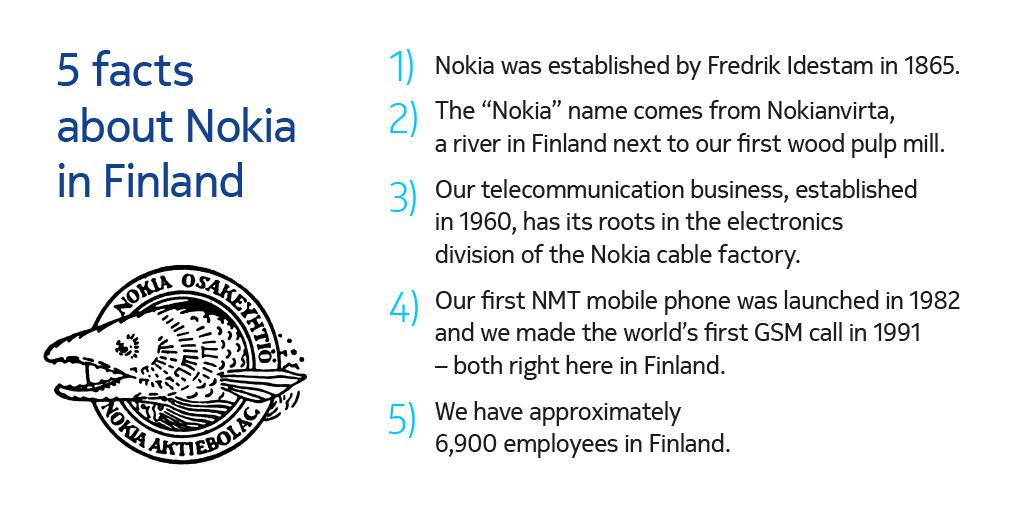
After diversifying into rubber, cables and electronics Nokia entered the world, that it would later conquer, of mobile communications in 1968
In 1979 Nokia and Salora got together to establish Mobira Oy, a radio telephone company. 1981 marked a new era for Nokia when the Nordic Mobile Telephone service was set up. It was the world's first international cellular network and Nokia launched its first car phone, Mobira Senator, in 1982.
The Mobira Talkman, a giant 'wireless' car phone was introduced in 1984. Much of the weight was attributed to its battery.
When the GSM network was rolled out in 1991, Nokia released its first digital handheld GSM phone, the Nokia 1011. The world's first first GSM call was also made using a Nokia device.
Nokia followed up on the 1011 with the Nokia 101 phone in 1992. The phone came with an extendible aerial.
Launched by Nokia in 1994, the Nokia 2110 was the first phone to feature the Nokia Tune as a ringtone. The Nokia Tune is derived from Gran Vals, a classical guitar piece, composed by Francisco Tarrega in the 19th century. The Nokia 2100 series went to to be a big success. Nokia had expected to sell about 400,000 units, but 20 million phones were sold the world over.
The banana-shaped Nokia 8110 was launched in 1996. This slider-phone found a place in popular culture when it was featured in the 1999 blockbuster The Matrix.
The 1997 Nokia 6110 was the first device to feature the addictive Snake game. The game is available on about 350 million mobile phones. The hot-selling 6110 also boasted of some other Nokia firsts: infra-red port and menu icons.
Launched in 1998, the Nokia 8810 was the first mobile phone without an external antenna. The slider form of the phone also added to its appeal. By 1998 Nokia was the world leader in mobile phones, a position it holds till date

2002 was an year of innovation at Nokia. The Nokia 6650 launched was Nokia's first 3G phone launched that year.
Also released in 2002, the Nokia 7650 was the first Nokia phone with a built-in camera. The 7650 was also one of the first Nokia phones to have a colour display
Another 2002 innovation at Nokia was the 3650. The Nokia 3650 was the first phone by Nokia to be able to record video
Nokia launched its mobile-phone-cum-handheld-gaming-device N-Gage in 2003. In 2009 Nokia announced that it will stop development of N-Gage games and would discontinue the N-Gage service by the end of 2010.
Nokia launched its Nseries phones in 2005. These entertainment-cum-communication devices form Nokia's top line of offerings. The N70, N90 and N91 were the first of the series to be introduced.
In April 2010, Nokia announced the N8, it's new flagship phone. The phone was launched in October 2010.
Nokia announced its first Windows Phone devices, Lumia 800 and Lumia 710 at the Nokia World 2011 in London on October 26
Nokia introduced its Asha range of phones in 2011
At the Mobile World Congress 2012, Nokia unveiled its Nokia 808 PureView smartphone with a 41 megapixel camera usinng a new camera technology. Though the phone was not a success, it laid the framework for cameras in future Nokia devices

In July 2013, Nokia introduced a new smartphone, the Lumia 1020, with a powerful 41-megapixel camera (last seen in the PureView 808) in a bid to catch up with rivals Samsung and Apple
On September 3, 2013 Microsoft and Nokia announced that Microsoft is buying Nokia's devices and services business, and getting access to the company's patents, for a total of 5.44 billion euros ($7.2 billion) in an effort to expand its share of the smartphone market. Microsoft will pay 3.79 billion euros ($5 billion) for the Nokia unit that makes mobile phones, including its line of Lumia smartphones that run Windows Phone software.
Foraying into the phablet market, Nokia announced the launch of its first 6-inch smartphones - the Lumia 1320 and Lumia 1520.
Nokia introduced its fist tablet - Lumia 2520 - in 2013.
Nokia announced its first-ever Android-based smartphones early this year 2015
The first three phones in the family - the Nokia X, X+ and XL - run on the new Nokia X software platform, that is based on Google's Android. These phones were later discontinued.
Nokia, on April 25, completed the 5.44 billion-euro ($7.5 billion) sale of its troubled cellphone and services division to Microsoft, ending a chapter in the former world leading cellphone maker's history that began with paper making in 1865.
In November 2014, Microsoft released the Lumia 535, the first Lumia phone without Nokia branding
No comments:
Post a Comment